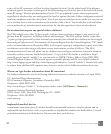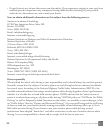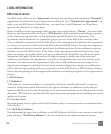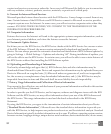
131 TWO User Guide - R1.0 - April 21, 2010
The exposure standard for wireless mobile phones employs a unit of measurement known as the
Specific Absorption Rate, or SAR. Tests for SAR are conducted with the phone transmitting at its
highest certified power level in all tested frequency bands. Although the SAR is determined at the
highest certified power level, the actual SAR level of the phone while operating can be well below the
maximum value. This is because the phone is designed to operate at multiple power levels so as to use
only the power required to reach the network. In general, the closer you are to a wireless base station
antenna, the lower the power output. Before a phone model is available for sale to the public, it must
be tested and certified to the FCC that it does not exceed the limit established by the government
adopted requirement for safe exposure. The tests are performed in positions and locations (e.g., at the
ear and worn on the body) as required by the FCC for each model.
The available scientific evidence does not show that any health problems are associated with using
low power wireless devices. There is no proof, however, that these low power wireless devices are
absolutely safe. Low power wireless devices emit low levels of radio frequency energy (RF) in the
microwave range while being used. Whereas high levels of RF can produce health effects (by heating
tissue), exposure to low-level RF that does not produce heating effects causes no known adverse
health effects. Many studies of low-level RF exposures have not found any biological effects. Some
studies have suggested that some biological effects might occur, but such findings have not been
confirmed by additional research.
In the United States and Canada, the SAR limit for mobile devices used by the public is 1.6 watts/kg
(W/kg) averaged over one gram of tissue. The FCC has granted an Equipment Authorization for this
wireless device with all reported SAR levels evaluated as in compliance with the FCC RF emission
guidelines. SAR information for this device is on file with the FCC and can be found under the
Display Grant section of http://www.fcc.gov/oet/fccid after searching on FCC ID APYNAR0066 for
the PB20ZU.
For the PB20ZU, the highest SAR value when tested for use at the ear is 1.29 W/Kg and when worn on
the body, as described in this user guide, is 0.755 W/Kg. (Body-worn measurements differ among
phone models, depending upon available accessories and FCC requirements.) While there may be
differences between the SAR levels of various phones and at various positions, they all meet the
government requirement for safe exposure.
Additional information on Specific Absorption Rates (SAR) can be found on the Cellular
Telecommunications & Internet Association (CTIA) website at http://www.phonefacts.net
Body-worn operation
This device was tested for typical body-worn operations with the back of the phone kept 2.0 cm from
the body. To maintain compliance with FCC RF exposure requirements, use only belt-clips, holsters,
or similar accessories that maintain a 2.0 cm separation distance between the user’s body and the
back of the phone, including the antenna. The use of belt-clips, holsters and similar accessories


















